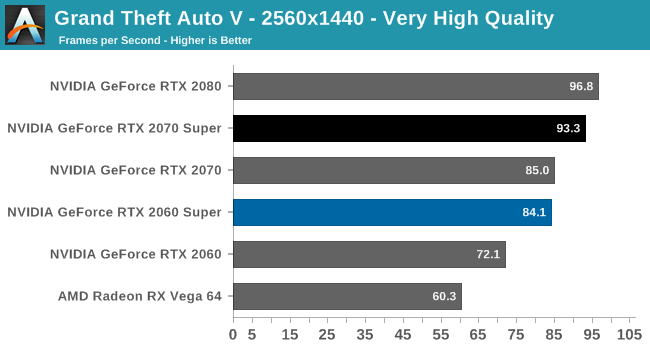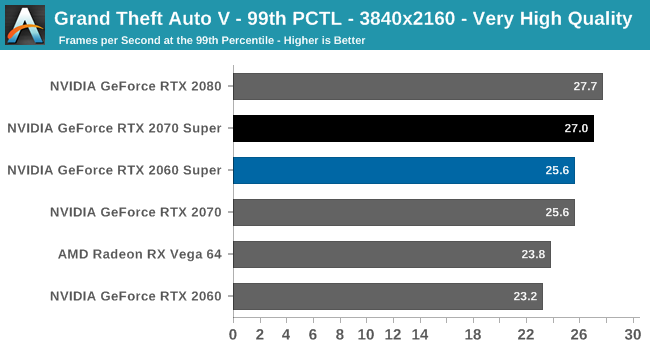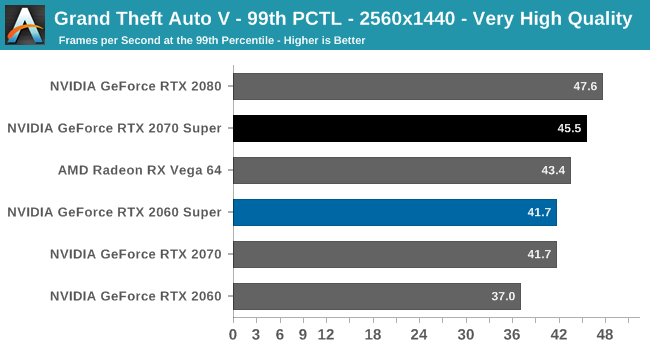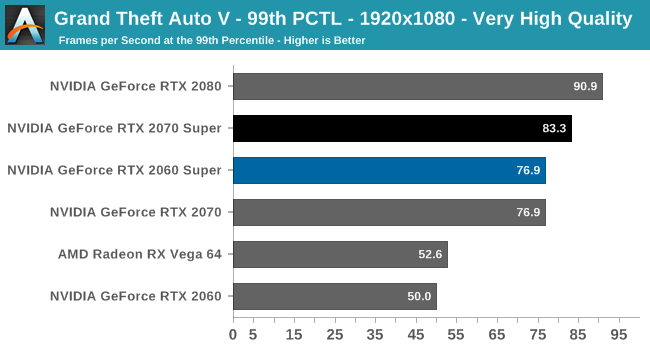The NVIDIA GeForce RTX 2070 Super & RTX 2060 Super Review: Smaller Numbers, Bigger Performance
by Ryan Smith on July 2, 2019 9:00 AM EST- Posted in
- GPUs
- GeForce
- NVIDIA
- Turing
- GeForce RTX
Grand Theft Auto V
Now a truly venerable title, GTA V is a veteran of past game suites that is still graphically demanding as they come. As an older DX11 title, it provides a glimpse into the graphically intensive games of yesteryear that don't incorporate the latest features. Originally released for consoles in 2013, the PC port came with a slew of graphical enhancements and options. Just as importantly, GTA V includes a rather intensive and informative built-in benchmark, somewhat uncommon in open-world games.
The settings are identical to its previous appearances, which are custom as GTA V does not have presets. To recap, a "Very High" quality is used, where all primary graphics settings turned up to their highest setting, except grass, which is at its own very high setting. Meanwhile 4x MSAA is enabled for direct views and reflections. This setting also involves turning on some of the advanced rendering features - the game's long shadows, high resolution shadows, and high definition flight streaming - but not increasing the view distance any further.
















281 Comments
View All Comments
coolkev99 - Tuesday, August 6, 2019 - link
I'm STILL running my 2500k. :-oGastec - Wednesday, July 17, 2019 - link
Because IT IS a high price for what it gives you.Opencg - Wednesday, July 3, 2019 - link
I just cannot back nvlink / sli. it is proven that developer and nvidia support fall short far too often. Sure you can run 4k 120fps most of the time but its not supported well enough across all titles. and issues like frame timing and imput lag are introduced. sli was good in older apis when it had the option for driver based sli aa. but newer apis require custom aa implementation and nobody has taken the time to make this tech work properly.Qasar - Wednesday, July 3, 2019 - link
Opencg you referring to SLI from 3dfx ?? i wonder how that version of SLI would work now a days.Opencg - Thursday, July 4, 2019 - link
Im mainly refering to how sli worked with older versions of direct x. In older versions the driver could force aa modes. With newer versions aa modes need to be programed in by the developer. For sli aa each card would render half of the samples for a given frame. The load on each card was almost the same. With alternating frame rendering each card renders every other frame and the load can vary from frame to frame. In the end it increases input lag or makes frame pacing less accurate or a little of both.Qasar - Friday, July 5, 2019 - link
ahh you're talking about nvidia's SLI.. not 3dfx's :-)Opencg - Saturday, July 6, 2019 - link
nvlink is sli. they changed the name and upgraded the bridge but the tech is functionally the same and has the same issues. (actually the issues are getting worse due to sli becoming less common and developers spending less time on it)Qasar - Saturday, July 6, 2019 - link
yep.. but 3dfx sli, and nvidia sli.. only share the abbreviation, nothing else... 3dfx SLI, Scan Line Interweave, nvidia sli Scalable link interface, 3dfx's version.. no need to create profiles or anything.. add the 2nd card.. see a performance boost right away... too bad that way of combining cards, doesnt work now a days...nathanddrews - Wednesday, July 3, 2019 - link
"NVLink"Good one! That had me laughing to myself for a good 20 seconds.
Gastec - Wednesday, July 17, 2019 - link
SHILL ALERT!